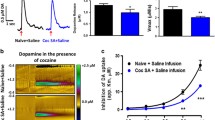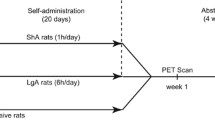Summary
The distribution of radioactivity following administration of either [3H]d-amphetamine or [3H]2-deoxy-d-glucose was examined by scintillation counting of 22 microdissected brain regions from rats pretreated with either acute or continuous amphetamine, or continuously administered labeled d-amphetamine. Animals continuously administered drug were sacrificed in behaviorally distinct stages of the continuous amphetamine syndrome, a potential animal model of amphetamine psychosis.
Both isotopes were heterogeneously distributed within brain, and their distributions were differentially affected by acute or continuous amphetamine regimens. While the distribution of either isotope in naive rats was characterized by greatest concentrations of counts in rostral rather than caudal regions, and grey-matter rather than white-matter structures, continuous amphetamine administration resulted in progressively increased retention of amphetamine by mesolimbic but not nigrostriatal brain regions; this was accompanied by locally enhanced levels of glucose utilization. This effect was predominantly localized in the nucleus accumbens, which exhibited the greatest retention of amphetamine and greatest relative increase in glucose utilization of any region studied during that stage of the continuous amphetamine syndrome thought to best model amphetamine psychosis. Alterations in amphetamine distribution and local levels of neural activity may reflect a change in the principal locus of control of amphetamine effects within brain as animals progress through the stages of the continuous amphetamine syndrome.
Similar content being viewed by others
References
Angrist B, Sathananthan G, Wilk S, Gershon S (1975) Amphetamine psychosis. Behavioral and biochemical aspects. In: Matthysse SW, Kety SS (eds) Catecholamines and schizophrenia, Pergamon Press, New York, pp 13–23
Axelrod J (1954) Studies on sympathomimetic amines. II. The biotransformation and physiological disposition of d- amphetamine, d-p-hydroxyamphetamine, and d-methamphetamine. J Pharmacol Exp Ther 110: 315–326
Bell DS (1965) A comparison of amphetamine psychosis and schizophrenia. Br J Psychiatry 111: 701–707
Bell DS (1973) The experimental reproduction of amphetamine psychosis. Arch Gen Psychiatry 29: 35–40
Brien JF, Peachey JE, Rogers BJ, Kitney JC (1977) Amphetamine-induced stereotyped behavior and brain concentrations of amphetamine and its hydroxylated metabolites in mice. J Pharm Pharmacol 29: 49–50
Connell P (1958) Amphetamine psychosis. Maudsley Monographs No 5. Oxford University Press, London
Costall B, Naylor RJ, Cannon JG, Lee T (1977) Differentiation of dopamine mechanisms mediating stereotyped behavior and hyperactivity in the nucleus accumbens and caudate-putamen. J Pharm Pharmacol 29: 337–342
Danielson TJ, Boulton AA (1976) Distribution and occurrence of amphetamine and parahydroxyamphetamine in tissues of the rat after injection of d-amphetamine sulphate. Eur J Pharmacol 37: 257–264
Davis JM (1975) A two-factor theory of schizophrenia. In: Matthysse SW, Kety SS (eds) Catecholamines and schizophrenia. Pergamon Press, New York, pp 25–29
Eison MS, Wilson JW, Ellison GD (1978) A refutable system for continuous amphetamine administration. Effects upon social behavior in rat colonies. Commun Psychopharmacol 2: 151–157
Ellison GD, Eison MS, Huberman HS (1978) Stages of constant amphetamine intoxication. Delayed appearance of abnormal social behaviors in rat colonies. Psychopharmacology (Berlin) 56: 293–299
Griffith J, Oates J, Cavanaugh J (1968) Paranoid episodes induced by drugs. J Am Med Assoc 205: 39
Huberman HS, Eison MS, Bryan KS, Ellison GD (1977) A slow- release pellet for chronic amphetamine administration. Eur J Pharmacol 45: 237–242
Jackson DM, Anden NE, Dahlstrom AA (1975) A functional effect of dopamine in the nucleus accumbens and some other dopamine rich parts of rat brain. Psychopharmacologia 45: 139–149
Jori A, Caccia S, Garattini S (1977) Possible storage of (+)-amphetamine in catecholamine terminals of the striatum and brainstem. Eur J Pharmacol 41: 275–279
Kelly PH, Iversen SD (1976) Selective 6-OHDA-induced destruction of mesolimbic dopamine neurons. Abolition of psychostimulant induced locomotor activity in rats. Eur J Pharmacol 40: 45–56
Kelly PH, Moore KE (1976) Mesolimbic dopaminergic neurons in the rotational model of nigrostriatal function. Nature 263: 695–696
Kelly PH, Moore KE (1977) Mesolimbic dopamine neurons. Effects of 6-hydroxydopamine induced destruction and receptor blockade on drug-induced rotation in rats. Psychopharmacology (Berlin) 55: 35–41
Kuhn CM, Schanberg SM, Breese GR (1977) Metabolism of amphetamine in rat brain tissue. Biochem Pharmacol 27: 343–351
Meltzer HY, Stahl SM (1976) The dopamine theory of schizophrenia. A review. Schrzophr Bull 2: 19–76
Nielsen EB, Lee TH, Ellison GD (1980) Following several days of continuous administration d-amphetamine acquires hallucinogen-like properties. Psychopharmacology (Berlin) 68: 197–200
Pellegrino LJ, Cushman AJ (1967) A stereotaxic atlas of the rat brain. Meredith, New York
Placidi G, Masuoka DT, Earle RW (1972) Distribution of (14C)-amphetamine in mouse brain. An autoradiographic study. Brain Res 38: 399–405
Price MTC, Fibiger HC (1974) Apomorphine and amphetamine stereotypy after 6-hydroxydopamine lesions of the substantia nigra. Eur J Pharmacol 29: 249–252
Sokoloff L (1977) Relation between physiological function and energy metabolism in the central nervous system. J Neurochem 29: 13–29
Sparber SB, Nagasawa S, Burklund KEA (1977) A mobilizable pool of d-amphetamine in adipose after daily administration to rats. Res Commun Chem Pathol Pharmacol 18: 423–431
Stevens JR (1973) An anatomy of schizophrenia? Arch Gen Psychiatry 29: 177–189
Wechsler LR, Savaki HE, Sokoloff L (1979) Effects of d- and 1- amphetamine on local cerebral glucose utilization in the conscious rat. J Neurochem 32: 15–22
Winer BJ (1971) Statistical principles in experimental design. McGraw Hill, London
Young RL, Gordon MW (1962) The disposition of (14C)-amphetamine in rat brain. J Neurochem 9: 161–167
Author information
Authors and Affiliations
Additional information
Supported by U.S.P.H.S. grant DA 02312
Rights and permissions
About this article
Cite this article
Eison, M.S., Eison, A.S. & Ellison, G. The regional distribution of d-amphetamine and local glucose utilization in rat brain during continuous amphetamine administration. Exp Brain Res 43, 281–288 (1981). https://doi.org/10.1007/BF00238369
Received:
Issue Date:
DOI: https://doi.org/10.1007/BF00238369




